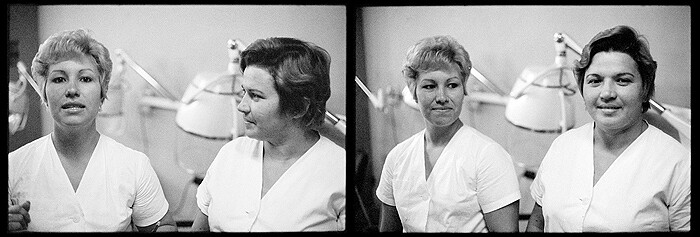Hairdressers, Trinidad, one of several diptychs in Martha Rosler’s “Cuba, January, 1981,” shows two women looking at each other. In the first image, the blonde addresses the camera, seemingly in mid-speech, while the brunette watches her in profile. In the accompanying image, the brunette smiles for the camera, while the blonde looks on. The similarity of the two images, side by side, sets off clearly the line between looking and being looked at. This line has often been Rosler’s subject: capturing what is at work in the space between images. So a simple reconfiguration of the gaze between hairdressers delineates the spectrum of our assumptions—about power, photography, and, well, haircuts. We can see, suddenly, what it was we were thinking.
This operation is so effective it is often taken for granted. Rancière famously described a montage from Rosler’s House Beautiful: Bringing the War Home (1967–72) as depicting “in the middle of a clear and spacious apartment, a Vietnamese man holding a dead child in his arms. The dead child was the intolerable reality concealed by comfortable American existence…”. Yet the man was actually a woman, the child was actually alive, and the “intolerable reality” had appeared in Life magazine, alongside, as it happens, advertisements and images of clear, spacious apartments. Rosler’s gesture was simply to move together, into the same frame, images that exist side by side, either in the same magazine or on the same rack. The material existence of the image is at issue, not its revelation. Rancière’s projected narrative of concealed realities is summoned by this difficult coexistence, precisely as it attempts to explain it away. The artist’s relentless focus on everyday life is an invitation to think the universal in terms of the particular, and not, as has often been assumed, the other way around.
Take Photo Shop, Havana (all works 1981), a fantastic picture. A younger woman and an older man sit on a bench under two framed pictures of children in a shop for studio portraiture. The pictures on the wall appear to be staged portraits: a girl smiling happily in a dress and a small boy with a manic grin against a generic background. All four people in Rosler’s frame appear happy, but with a crucial distinction: the pictures on the wall are exemplary; they’re chosen to be advertisements for pictures as such, while the people sitting beneath are contingent. In comparison, their happiness has been captured almost by chance. In the space separating the curated advertising photos from the seated couple lies the problem of representing Cuba, as the self-consciousness of the Communist project would intersect uncomfortably with the aesthetic decision of the photographer. Reduced either to staged happiness or staged grief, everyday life cannot appear separately from a validation or a critique of the regime. The latter would demand the couple’s obvious dejection, while the former cannot make out the distinction between the images of happiness deployed on the wall and its contingent appearance underneath.
This is precisely opposite the problem of documentary photography diagnosed by Rosler in “In Around and Afterthoughts (on Documentary Photography)” (1981). As she wrote then:
In liberal documentary, poverty and oppression are almost invariably equated with misfortunes caused by natural disasters; Causality is vague, blame is not assigned, fate cannot be overcome. Liberal documentary blames neither the victims nor their willful oppressors—unless they happen to be under the influence of our own global enemy World Communism.
If documentary photography courted inadequacy and an “impoverishment of representational strategies,” as Rosler demonstrated in The Bowery in two inadequate descriptive systems (1974–75), then here the threat is that of super-adequacy, of over-determination or ideological saturation. Photo Shop, Havana thus seeks everyday life beneath the image, while The Bowery looked beyond it.
“Cuba, January, 1981” is twice remarkable. First, for how completely different it looks from most anything else Rosler has ever done, but, secondly, despite this, for how deeply it complements her interests from the period. Subtle, but with trademark clarity, the show is that rare thing, beautiful both in form and for the history it brings to mind.





